
Solar-powered aircraft are electric aircraft that can be an airplane, blimp, or airship and use either a battery or hydrogen to store the energy produced by the solar cells and use that energy at night when the sun isn't shining.

Solar-powered aircraft are electric aircraft that can be an airplane, blimp, or airship and use either a battery or hydrogen to store the energy produced by the solar cells and use that energy at night when the sun isn't shining.
Solar-powered aircraft do not require fuel, so they don't require oxygen, and they are able to operate at altitudes over 20 kilometres (12 mi) to 100 kilometres (62 mi) for months at a time. [1] [2]
Conventional passenger or cargo aircraft usages aren't practical yet with modern technology, but high-altitude platform stations and long-endurance missions over a fixed location with unmanned aircraft or airships are feasible. Thus solar-powered aircraft could be used in telecommunications, video/imagery, flight control by transporting airport surveillance radars, in precipitation detection by transporting weather radars, geopositioning Global Positioning Systems (GPS), [3] and other pseudo satellite [4] applications that transpond the data with ground stations.
This list is non-exhaustive.

Solar Airship One is being developed by Euro Airship and is planning to launch a would tour in 2026 and fly by 25 countries in 20 days as it travels around the world non-stop. It will be autonomous and use electrolysis to store hydrogen to keep moving at night when the sun isn't shining. [11]

An aircraft is a vehicle that is able to fly by gaining support from the air. It counters the force of gravity by using either static lift or the dynamic lift of an airfoil, or, in a few cases, direct downward thrust from its engines. Common examples of aircraft include airplanes, helicopters, airships, gliders, paramotors, and hot air balloons.

An aerobot is an aerial robot, usually used in the context of an unmanned space probe or unmanned aerial vehicle.
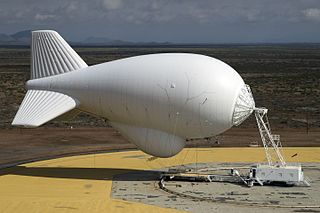
An aerostat is a lighter-than-air aircraft that gains its lift through the use of a buoyant gas. Aerostats include unpowered balloons and powered airships. A balloon may be free-flying or tethered. The average density of the craft is lower than the density of atmospheric air, because its main component is one or more gasbags, a lightweight skin containing a lifting gas to provide buoyancy, to which other components such as a gondola containing equipment or people are attached. Especially with airships, the gasbags are often protected by an outer envelope.

A solar vehicle or solar electric vehicle is an electric vehicle powered completely or significantly by direct solar energy. Usually, photovoltaic (PV) cells contained in solar panels convert the sun's energy directly into electric energy.

A hybrid airship is a powered aircraft that obtains some of its lift as a lighter-than-air (LTA) airship and some from aerodynamic lift as a heavier-than-air aerodyne.

Solar Impulse is a Swiss long-range experimental solar-powered aircraft project, and also the name of the project's two operational aircraft. The privately financed project is led by Swiss engineer and businessman André Borschberg and Swiss psychiatrist and balloonist Bertrand Piccard, who co-piloted Breitling Orbiter 3, the first balloon to circle the world non-stop. The Solar Impulse project's goals were to make the first circumnavigation of the Earth by a piloted fixed-wing aircraft using only solar power and to bring attention to clean technologies.

An electric aircraft is an aircraft powered by electricity. Electric aircraft are seen as a way to reduce the environmental effects of aviation, providing zero emissions and quieter flights. Electricity may be supplied by a variety of methods, the most common being batteries. Most have electric motors driving propellers or turbines.

The flight endurance record is the longest amount of time an aircraft of a particular category spent in flight without landing. It can be a solo event, or multiple people can take turns piloting the aircraft, as long as all pilots remain in the aircraft. The limit initially was the amount of fuel that could be stored for the flight, but aerial refueling extended that parameter. Due to safety concerns, the Fédération Aéronautique Internationale (FAI) no longer recognizes new records for the duration of crewed airplane or glider flights and has never recognized any duration records for helicopters.

The Zephyr is a series of high-altitude platform station aircraft produced by Airbus. They were designed originally by QinetiQ, a commercial offshoot of the UK Ministry of Defence. In July 2010, the Zephyr 7 flew during 14 days. In March 2013, the project was sold to Airbus Defence and Space. In the summer of 2022, the Zephyr 8/S flew for 64 days.

A high-altitude platform station also known as atmospheric satellite is a long endurance, high altitude aircraft able to offer observation or communication services similarly to artificial satellites. Mostly unmanned aerial vehicles (UAVs), they remain aloft through atmospheric lift, either aerodynamic like airplanes, or aerostatic like airships or balloons. High-altitude long endurance (HALE) military drones can fly above 60,000 ft over 32 hours, while civil HAPS are radio stations at an altitude of 20 to 50 km above waypoints, for weeks.

The Helios Prototype was the fourth and final aircraft developed as part of an evolutionary series of solar- and fuel-cell-system-powered unmanned aerial vehicles. AeroVironment, Inc. developed the vehicles under NASA's Environmental Research Aircraft and Sensor Technology (ERAST) program. They were built to develop the technologies that would allow long-term, high-altitude aircraft to serve as atmospheric satellites, to perform atmospheric research tasks as well as serve as communications platforms. It was developed from the NASA Pathfinder and NASA Centurion aircraft.

The Mauro Solar Riser is an American biplane ultralight electric aircraft that was the first crewed aircraft to fly on solar power. It was also only the second solar-powered aircraft to fly, after the uncrewed AstroFlight Sunrise, which had first flown 4+1⁄2 years earlier.
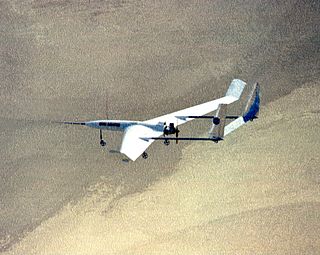
A Mars aircraft is a vehicle capable of sustaining powered flight in the atmosphere of Mars. So far, the Mars helicopter Ingenuity is the only aircraft ever to fly on Mars, completing 72 successful flights covering 17.242 km (10.714 mi) in 2 hours, 8 minutes and 48 seconds of flight time. Ingenuity operated on Mars for 1042 sols, until its rotor blades, possibly all four, were damaged, causing NASA to retire the craft.
Urban Air Mobility (UAM) is the use of small, highly automated aircraft to carry passengers or cargo at lower altitudes in urban and suburban areas which have been developed in response to traffic congestion. It usually refers to existing and emerging technologies such as traditional helicopters, vertical-takeoff-and-landing aircraft (VTOL), electrically propelled, vertical-takeoff-and-landing aircraft (eVTOL), and unmanned aerial vehicles (UAVs). These aircraft are characterized by the use of multiple electric-powered rotors or fans for lift and propulsion, along with fly-by-wire systems to control them. Inventors have explored urban air mobility concepts since the early days of powered flight. However, advances in materials, computerized flight controls, batteries and electric motors improved innovation and designs beginning in the late 2010s. Most UAM proponents envision that the aircraft will be owned and operated by professional operators, as with taxis, rather than by private individuals.
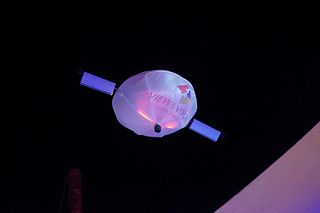
The Hybrid-Airplane Technology H-Aero is a small German hybrid electric unmanned aerial vehicle UAV by a Baden-Baden based start-up Hybrid-Airplane Technology GmbH. Compared to some other UAVs it features vertical take-off and landing and extended flight endurance.
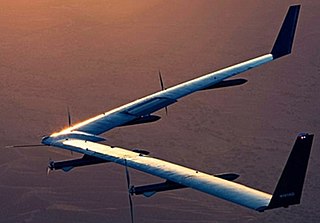
The Facebook Aquila is an experimental solar-powered drone developed by Facebook for use as an atmospheric satellite, intended to act as relay stations for providing internet access to remote areas. The Aquila first flew on 28 June 2016 with a second aircraft successfully flying in 2017. Internal development of the Aquila aircraft was stopped in June 2018.
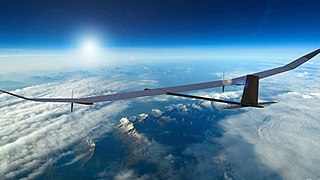
The BAE Systems Persistent High Altitude Solar Aircraft (PHASA-35) is a High-Altitude Long Endurance (HALE) unmanned aerial vehicle (UAV) developed by BAE Systems in collaboration with Prismatic. Designed as a cheaper alternative to satellites, the aircraft can be used for surveillance, border control, communications and disaster relief with a potential ability to stay airborne for up to 12 months. Developed in less than two years, the aircraft carried out its first flight in February 2020 and further trials are currently ongoing.